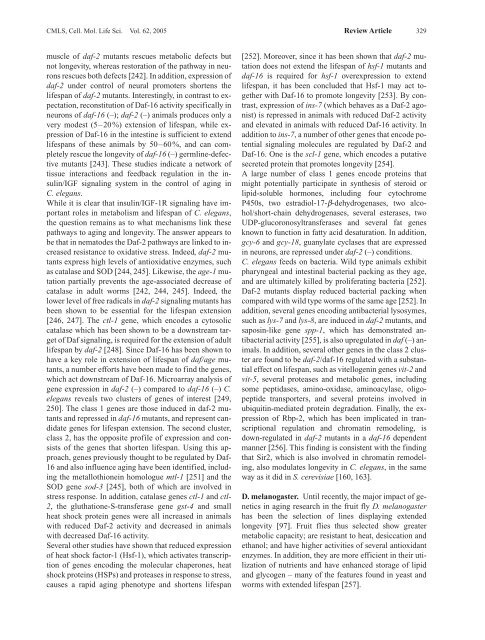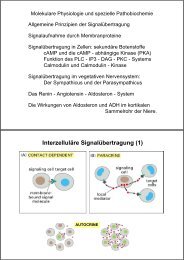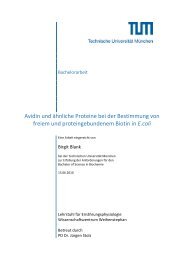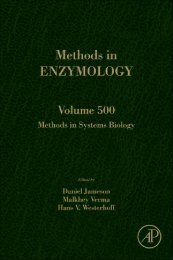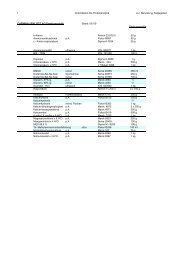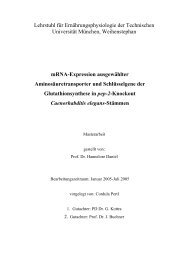Review The role of insulin and IGF-1 signaling in longevity
Review The role of insulin and IGF-1 signaling in longevity
Review The role of insulin and IGF-1 signaling in longevity
Create successful ePaper yourself
Turn your PDF publications into a flip-book with our unique Google optimized e-Paper software.
CMLS, Cell. Mol. Life Sci. Vol. 62, 2005 <strong>Review</strong> Article 329<br />
muscle <strong>of</strong> daf-2 mutants rescues metabolic defects but<br />
not <strong>longevity</strong>, whereas restoration <strong>of</strong> the pathway <strong>in</strong> neurons<br />
rescues both defects [242]. In addition, expression <strong>of</strong><br />
daf-2 under control <strong>of</strong> neural promoters shortens the<br />
lifespan <strong>of</strong> daf-2 mutants. Interest<strong>in</strong>gly, <strong>in</strong> contrast to expectation,<br />
reconstitution <strong>of</strong> Daf-16 activity specifically <strong>in</strong><br />
neurons <strong>of</strong> daf-16 (–); daf-2 (–) animals produces only a<br />
very modest (5–20%) extension <strong>of</strong> lifespan, while expression<br />
<strong>of</strong> Daf-16 <strong>in</strong> the <strong>in</strong>test<strong>in</strong>e is sufficient to extend<br />
lifespans <strong>of</strong> these animals by 50–60%, <strong>and</strong> can completely<br />
rescue the <strong>longevity</strong> <strong>of</strong> daf-16 (–) germl<strong>in</strong>e-defective<br />
mutants [243]. <strong>The</strong>se studies <strong>in</strong>dicate a network <strong>of</strong><br />
tissue <strong>in</strong>teractions <strong>and</strong> feedback regulation <strong>in</strong> the <strong><strong>in</strong>sul<strong>in</strong></strong>/<strong>IGF</strong><br />
<strong>signal<strong>in</strong>g</strong> system <strong>in</strong> the control <strong>of</strong> ag<strong>in</strong>g <strong>in</strong><br />
C. elegans.<br />
While it is clear that <strong><strong>in</strong>sul<strong>in</strong></strong>/<strong>IGF</strong>-1R <strong>signal<strong>in</strong>g</strong> have important<br />
<strong>role</strong>s <strong>in</strong> metabolism <strong>and</strong> lifespan <strong>of</strong> C. elegans,<br />
the question rema<strong>in</strong>s as to what mechanisms l<strong>in</strong>k these<br />
pathways to ag<strong>in</strong>g <strong>and</strong> <strong>longevity</strong>. <strong>The</strong> answer appears to<br />
be that <strong>in</strong> nematodes the Daf-2 pathways are l<strong>in</strong>ked to <strong>in</strong>creased<br />
resistance to oxidative stress. Indeed, daf-2 mutants<br />
express high levels <strong>of</strong> antioxidative enzymes, such<br />
as catalase <strong>and</strong> SOD [244, 245]. Likewise, the age-1 mutation<br />
partially prevents the age-associated decrease <strong>of</strong><br />
catalase <strong>in</strong> adult worms [242, 244, 245]. Indeed, the<br />
lower level <strong>of</strong> free radicals <strong>in</strong> daf-2 <strong>signal<strong>in</strong>g</strong> mutants has<br />
been shown to be essential for the lifespan extension<br />
[246, 247]. <strong>The</strong> ctl-1 gene, which encodes a cytosolic<br />
catalase which has been shown to be a downstream target<br />
<strong>of</strong> Daf <strong>signal<strong>in</strong>g</strong>, is required for the extension <strong>of</strong> adult<br />
lifespan by daf-2 [248]. S<strong>in</strong>ce Daf-16 has been shown to<br />
have a key <strong>role</strong> <strong>in</strong> extension <strong>of</strong> lifespan <strong>of</strong> daf/age mutants,<br />
a number efforts have been made to f<strong>in</strong>d the genes,<br />
which act downstream <strong>of</strong> Daf-16. Microarray analysis <strong>of</strong><br />
gene expression <strong>in</strong> daf-2 (–) compared to daf-16 (–) C.<br />
elegans reveals two clusters <strong>of</strong> genes <strong>of</strong> <strong>in</strong>terest [249,<br />
250]. <strong>The</strong> class 1 genes are those <strong>in</strong>duced <strong>in</strong> daf-2 mutants<br />
<strong>and</strong> repressed <strong>in</strong> daf-16 mutants, <strong>and</strong> represent c<strong>and</strong>idate<br />
genes for lifespan extension. <strong>The</strong> second cluster,<br />
class 2, has the opposite pr<strong>of</strong>ile <strong>of</strong> expression <strong>and</strong> consists<br />
<strong>of</strong> the genes that shorten lifespan. Us<strong>in</strong>g this approach,<br />
genes previously thought to be regulated by Daf-<br />
16 <strong>and</strong> also <strong>in</strong>fluence ag<strong>in</strong>g have been identified, <strong>in</strong>clud<strong>in</strong>g<br />
the metallothione<strong>in</strong> homologue mtl-1 [251] <strong>and</strong> the<br />
SOD gene sod-3 [245], both <strong>of</strong> which are <strong>in</strong>volved <strong>in</strong><br />
stress response. In addition, catalase genes ctl-1 <strong>and</strong> ctl-<br />
2, the gluthatione-S-transferase gene gst-4 <strong>and</strong> small<br />
heat shock prote<strong>in</strong> genes were all <strong>in</strong>creased <strong>in</strong> animals<br />
with reduced Daf-2 activity <strong>and</strong> decreased <strong>in</strong> animals<br />
with decreased Daf-16 activity.<br />
Several other studies have shown that reduced expression<br />
<strong>of</strong> heat shock factor-1 (Hsf-1), which activates transcription<br />
<strong>of</strong> genes encod<strong>in</strong>g the molecular chaperones, heat<br />
shock prote<strong>in</strong>s (HSPs) <strong>and</strong> proteases <strong>in</strong> response to stress,<br />
causes a rapid ag<strong>in</strong>g phenotype <strong>and</strong> shortens lifespan<br />
[252]. Moreover, s<strong>in</strong>ce it has been shown that daf-2 mutation<br />
does not extend the lifespan <strong>of</strong> hsf-1 mutants <strong>and</strong><br />
daf-16 is required for hsf-1 overexpression to extend<br />
lifespan, it has been concluded that Hsf-1 may act together<br />
with Daf-16 to promote <strong>longevity</strong> [253]. By contrast,<br />
expression <strong>of</strong> <strong>in</strong>s-7 (which behaves as a Daf-2 agonist)<br />
is repressed <strong>in</strong> animals with reduced Daf-2 activity<br />
<strong>and</strong> elevated <strong>in</strong> animals with reduced Daf-16 activity. In<br />
addition to <strong>in</strong>s-7, a number <strong>of</strong> other genes that encode potential<br />
<strong>signal<strong>in</strong>g</strong> molecules are regulated by Daf-2 <strong>and</strong><br />
Daf-16. One is the scl-1 gene, which encodes a putative<br />
secreted prote<strong>in</strong> that promotes <strong>longevity</strong> [254].<br />
A large number <strong>of</strong> class 1 genes encode prote<strong>in</strong>s that<br />
might potentially participate <strong>in</strong> synthesis <strong>of</strong> steroid or<br />
lipid-soluble hormones, <strong>in</strong>clud<strong>in</strong>g four cytochrome<br />
P450s, two estradiol-17-b-dehydrogenases, two alcohol/short-cha<strong>in</strong><br />
dehydrogenases, several esterases, two<br />
UDP-glucoronosyltransferases <strong>and</strong> several fat genes<br />
known to function <strong>in</strong> fatty acid desaturation. In addition,<br />
gcy-6 <strong>and</strong> gcy-18, guanylate cyclases that are expressed<br />
<strong>in</strong> neurons, are repressed under daf-2 (–) conditions.<br />
C. elegans feeds on bacteria. Wild type animals exhibit<br />
pharyngeal <strong>and</strong> <strong>in</strong>test<strong>in</strong>al bacterial pack<strong>in</strong>g as they age,<br />
<strong>and</strong> are ultimately killed by proliferat<strong>in</strong>g bacteria [252].<br />
Daf-2 mutants display reduced bacterial pack<strong>in</strong>g when<br />
compared with wild type worms <strong>of</strong> the same age [252]. In<br />
addition, several genes encod<strong>in</strong>g antibacterial lysosymes,<br />
such as lys-7 <strong>and</strong> lys-8, are <strong>in</strong>duced <strong>in</strong> daf-2 mutants, <strong>and</strong><br />
sapos<strong>in</strong>-like gene spp-1, which has demonstrated antibacterial<br />
activity [255], is also upregulated <strong>in</strong> daf (–) animals.<br />
In addition, several other genes <strong>in</strong> the class 2 cluster<br />
are found to be daf-2/daf-16 regulated with a substantial<br />
effect on lifespan, such as vitellogen<strong>in</strong> genes vit-2 <strong>and</strong><br />
vit-5, several proteases <strong>and</strong> metabolic genes, <strong>in</strong>clud<strong>in</strong>g<br />
some peptidases, am<strong>in</strong>o-oxidase, am<strong>in</strong>oacylase, oligopeptide<br />
transporters, <strong>and</strong> several prote<strong>in</strong>s <strong>in</strong>volved <strong>in</strong><br />
ubiquit<strong>in</strong>-mediated prote<strong>in</strong> degradation. F<strong>in</strong>ally, the expression<br />
<strong>of</strong> Rbp-2, which has been implicated <strong>in</strong> transcriptional<br />
regulation <strong>and</strong> chromat<strong>in</strong> remodel<strong>in</strong>g, is<br />
down-regulated <strong>in</strong> daf-2 mutants <strong>in</strong> a daf-16 dependent<br />
manner [256]. This f<strong>in</strong>d<strong>in</strong>g is consistent with the f<strong>in</strong>d<strong>in</strong>g<br />
that Sir2, which is also <strong>in</strong>volved <strong>in</strong> chromat<strong>in</strong> remodel<strong>in</strong>g,<br />
also modulates <strong>longevity</strong> <strong>in</strong> C. elegans, <strong>in</strong> the same<br />
way as it did <strong>in</strong> S. cerevisiae [160, 163].<br />
D. melanogaster. Until recently, the major impact <strong>of</strong> genetics<br />
<strong>in</strong> ag<strong>in</strong>g research <strong>in</strong> the fruit fly D. melanogaster<br />
has been the selection <strong>of</strong> l<strong>in</strong>es display<strong>in</strong>g extended<br />
<strong>longevity</strong> [97]. Fruit flies thus selected show greater<br />
metabolic capacity; are resistant to heat, desiccation <strong>and</strong><br />
ethanol; <strong>and</strong> have higher activities <strong>of</strong> several antioxidant<br />
enzymes. In addition, they are more efficient <strong>in</strong> their utilization<br />
<strong>of</strong> nutrients <strong>and</strong> have enhanced storage <strong>of</strong> lipid<br />
<strong>and</strong> glycogen – many <strong>of</strong> the features found <strong>in</strong> yeast <strong>and</strong><br />
worms with extended lifespan [257].


